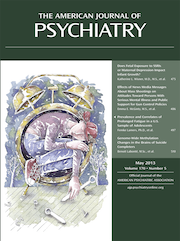A surgeon in Chicago performs a laparotomy to cure his son’s psychosis. A celebrity murder trial hinges on a psychiatric diagnosis. An upstart psychiatrist is the first in North America to publicize a method for classifying mental illnesses, only later to repudiate it. Richard Noll brings these and other tales to life in American Madness: The Rise and Fall of Dementia Praecox as he elaborates the history of how psychosis was named, classified, and understood in early 20th-century America.
Noll begins in 1892, when Swiss pathologist Adolf Meyer, age 25, crossed the Atlantic to look for work. At the Illinois Eastern Hospital for the Insane, Meyer’s lectures on what he knew of psychiatry were received enthusiastically, and his advocacy for the mentally ill soon reached the ears of the governor of Illinois. Through Meyer’s work, the American psychiatric community came to accept a distinct label for psychosis: Emil Kraeplin’s concept of dementia praecox. Until that time, asylum patients had generally been labeled simply “insane,” following the theory that all mental illness derived from a “unitary psychosis.”
But dementia praecox fell out of popularity as quickly as it had risen. Central to Kraeplin’s concept was its course of irreversible deterioration—definable only in retrospect. Consequently, young people with an array of emotional or behavioral disturbances seemed at risk, an alarming prospect. Clinical observations in America, however, contradicted this notion: many patients recovered, while others proved to be much less impaired than the label “dementia” had suggested. Becoming less and less enamored of Kraeplin’s “prognostic gloom,” Meyer and other American psychiatrists redefined dementia praecox, positing a “premorbid personality” that delimited those at risk and dovetailed with recently elaborated psychoanalytic concepts such as unconscious conflict.
Noll chronicles how this American dementia praecox was, ironically, fertile soil for the introduction of its replacement: Eugen Bleuler’s theory of schizophrenia. Bleuler viewed hallucinations, delusions, and dementia as secondary symptoms, “which arise as reactions … to environmental influences and to [the psyche’s] own strivings” (p. 236), Splitting, another element of Bleuler’s theory, made schizophrenia attractive because “psychological processes that were split could, theoretically, be reunited.” Bleuler’s ideas of reactions to the environment, hope for cure, and a premorbid “latent” schizophrenia resonated with the evolving American concept of psychosis. A. A. Brill, a disciple of Meyer’s who had studied with Bleuler in Zurich, published the first American report of schizophrenia in the
American Journal of Insanity (the precursor of the
American Journal of Psychiatry) in 1909 (
1). By the 1910s and 1920s, Bleuler’s schizophrenia, not yet dominant in Europe, had largely supplanted Kraeplin’s dementia praecox in America. The schizophrenia that we diagnose today is an American amalgam of these two European theories.
Tales of personal drama enliven Noll’s story in a way that few would imagine possible for a historical account of nosology. Kraeplinian terminology exploded into popular awareness in 1907, when the New York Times and newspapers across America sensationalized the trial of a troubled millionaire who had shot another millionaire, focusing on the defendant’s possible psychiatric diagnoses. Meyer, insecure that he had contributed nothing original to psychiatry, ultimately spurned the concept of dementia praecox and championed instead the premorbid personality. Noll poignantly describes the desperation of a surgeon whose son was diagnosed with dementia praecox. Spurred on by Kraeplin’s idea that dementia praecox arose from a systemic process (“autointoxication”), the surgeon’s research convinced him that the problem lay in the intestinal tract. In 1916, he operated on his son. Tragically, the boy died.
Throughout his narrative, Noll encourages the reader to consider the implications of viewing “madness” in particular ways. As Kenneth Kendler has observed (
2), if the tape of history were rewound and replayed a thousand times, we would probably not arrive at the same system of classification each time. We are reminded that scientific theories are as much historical accidents as they are accurate partitions of the natural world. Therefore, Noll admonishes us not to let classification schemes override observed clinical data.
In the epilogue, Noll, no stranger to contrarian positions (
3), discusses the relevance of this lesson to the revisions being considered for DSM-5. Broadening his comments to address nearly all DSM categories, he points out the pitfalls of the categorical approach to diagnosis and notes particular risk in the dimensional approach. “If discrete conceptual boundaries between disorders can dissolve,” he posits ominously, “so can the trust of the American people in psychiatry’s claim to be a branch of medicine” (p. 285). He seems equally displeased with DSM-5’s attempt to combine dimensional and categorical methods, although he presents no alternative.
This book is targeted to the lay public; its style is dramatic. Among professional readers, American Madness is most likely to be of interest to those who specialize in psychosis, who are concerned with psychiatric nosology, or who have a particular interest in the history and sociology of medicine.

